Abstract
Coal gangue (CG) is a residual product from coal mining and washing processes. The reutilization of CG to produce geopolymers is a low-carbon disposal strategy for this material. In this study, the calcined CG (CG700°C) was used as aluminosilicate precursors, and the effects of alkali activators (i.e., Na2SiO3/NaOH, NaOH concentration, and liquid–solid) on the mechanical characteristics and microstructure of CG700°C-based geopolymers were investigated. The findings indicated that the specimens with a liquid–solid ratio of 0.50 (G2.0-10-0.50) exhibited a compact microstructure and attained a compressive strength of 24.75 MPa. Moreover, increasing the Na2SiO3/NaOH mass ratio has shortened the setting times and facilitated geopolymer gel formation, resulting in a denser microstructure and improved compressive strength. The higher NaOH concentrations of alkali activators facilitated the dissolution of CG700°C particles, and the geopolymerization process was more dependent on the condensation of SiO4 and AlO4 ions, which promoted the formation of geopolymer networks. Conversely, an increase in the liquid–solid ratio from 0.50 to 0.65 had a negative impact on compressive strength enhancement, impeding the polycondensation rate. Examination through scanning electron microscopy and mercury intrusion porosimetry revealed that employing a lower Na2SiO3/NaOH mass ratio (G1.2-10-0.55), smaller NaOH concentrations (G2.0-8-0.55), and a higher liquid–solid ratio (G2.0-10-0.65) led to the presence of larger pores, resulting in decreased 28 days compressive strength values (15.87 MPa, 13.25 MPa, and 14.92 MPa, respectively), and a less compact structure. The results suggest that the performance of CG700°C-based geopolymers is significantly influenced by alkali activators.
1. Introduction
Geopolymers, proposed by Joseph Davidovits [1], are inorganic polymeric materials that exhibit excellent performance in several areas, including fire resistance, acid resistance, and the solidification of heavy metal wastes [2,3,4]. Over the last few decades, geopolymers have received considerable attention owing to their superior performance and smaller environmental footprint [5,6,7,8]. Statistically, the CO2 emission of the geopolymer products with a typical feedstock is approximately 44–64% lower than that of ordinary Portland cement [9]. Geopolymers are normally synthesized through aluminosilicate precursors and alkali activators [10]. The precursors primarily originate from byproducts (e.g., fly ash [11,12,13], ground granulated blast-furnace slag [14], and red mud [15]) or natural minerals (e.g., halloysite [16,17] and kaolinite [18,19]), while the alkali activators are typically composed of potassium (or sodium) hydroxides and silicates.
Coal gangue (CG) is a byproduct that is separated during the coal mining and washing processes. The production of CG is approximately 10–20% of the total coal output [20,21,22,23]. As of now, enormous amounts of CG have accumulated around the world. CG waste in China has reached 7 billion tons and continues to grow [10]. In the past, CG was normally used for stacking or landfilling; these discharge methods not only occupied land resources but also caused significant soil, water, and air pollution [24,25]. In addition, researchers have demonstrated the use of CG in building materials such as coarse aggregates [26,27], sintered bricks [28], and paved roads [29]. However, the mechanical properties of the products are negatively influenced by the CG waste, which has more porosity and higher water absorption. Karimipour et al. [27] reported that when the natural aggregates were replaced by CG aggregates at 25%, the compressive strength and elastic modulus decreased by 29% and 20%, respectively. Guan et al. [30] showed that CG concrete exhibited lower frost resistance in a freeze-thaw environment compared to normal concrete. Therefore, there is an urgent need to explore alternative uses for CG.
CG waste contains a large amount of silicate and aluminate materials, the main components of CG waste are kaolinite, quartz, muscovite, etc. [20,21,22]. Studies have attempted to use CG to prepare geopolymers. Zhang et al. [31] found a thermal temperature of 800 °C was suitable for the pozzolanic reactivity of CG, and the calcined CG prepared geopolymers have good performance. As the temperature reached 900 °C, the mechanical properties of CG-based geopolymers decreased, as reported by Zhou et al. [32]. Li et al. [20] discussed the effects of CG particle size on the compressive strength of geopolymers and the results showed that the 200 mesh of CG could obtain the desired compressive strength for geopolymers. Han et al. [21] investigated the geopolymers incorporating CG and slag precursors, and their findings showed that the compressive strength of geopolymers was more than 40 MPa. Furthermore, Geng et al. [22] mixed CG with red mud to produce geopolymers, and the results showed that CG with red mud at a ratio of 2:8 was appropriate for preparing geopolymers. However, the present research on CG-based geopolymers is mainly focused on calcination temperature, particle size, or the mixing materials for the precursors. In addition, alkali activators, which are essential in determining the composition and mechanical properties, significantly influence the performance of geopolymers [33,34,35,36,37].
A study reported that the silicate modulus (SiO2/Na2O) and the alkalinity of the solution significantly influenced the autogenous shrinkage of alkali-activated slag cement (AASC) [34]. The findings revealed that the silicate modulus of 1.0 enhanced geopolymerization in the AASC paste. Moreover, the NaOH concentration on the mechanical characteristics of geopolymers derived from fly ash was investigated [35,36,38], Phoo-ngernkham et al. [35] reported that the NaOH concentration of 14 mol/L was optimum for preparing the geopolymers, which improved the mechanical strength, which is consistent with the conclusions conducted by Somna et al. [38]. However, Guo et al. [36] reported that a modulus of 1.5 was favored for fly ash-based geopolymers, this was in contrast to the result (1.0) of AASC. In addition, Guo et al. [36,37] reported that water significantly influenced kaolin-based geopolymers by facilitating the dissolution of aluminosilicates or ion diversion during the geopolymerization process. When more water was introduced into the geopolymers, the geopolymerization process would be suppressed, leading to a reduction in the compressive strength. The previous study on various precursor materials such as slag cement, fly ash, and kaolin indicated different effects of alkali activators on mechanical properties. However, the application of alkali activators in CG-based geopolymers has rarely been investigated, resulting in an inadequate understanding of the effects of how alkali activators impact the mechanical properties of CG-based geopolymers.
In this study, the CG-based geopolymers were prepared using CG as a precursor and a variety of alkali activators consisting of NaOH and Na2SiO3 solutions. The effects of the Na2SiO3/NaOH mass ratio, NaOH concentration, and liquid–solid ratio on the mechanical properties of CG-based geopolymers were investigated. The mineral composition, microstructure, and mechanism properties of the CG-based geopolymers have been analyzed via X-ray diffraction (XRD), Fourier-transform infrared (FTIR) spectroscopy, scanning electron microscopy (SEM), and energy-dispersive X-ray (EDX) spectroscopy. Furthermore, the pore characteristics and parameters of the geopolymers were detected by mercury intrusion porosimetry (MIP). This study aimed to provide a better understanding of alkali activators on the geopolymerization process of CG-based geopolymers, thereby contributing to the reutilization of CG waste.
2. Materials and Methods
2.1. Materials
The CG was acquired from Hongqi Coal Industry Co., Ltd., located in Zhengzhou, China. The chemical compositions were measured using X-ray fluorescence spectroscopy (Table 1). The main chemical components of CG were SiO2 and Al2O3, which together accounted for 86.12 wt% of the total content. CG powers were subjected to calcination in a muffle furnace at 700 °C for a duration of 3 h, with a heating rate of 10 °C/min. The calcined CG was denoted as CG700°C.

Table 1.
Main chemical composition of CG (wt%).
The CG was gray before being calcined (Figure 1a), and the CG700°C became red as it contained iron oxides during the calcination (Figure 1b). The particle size distributions of CG700°C were shown in Figure 1c, with a d50 particle size of 5.59 μm.
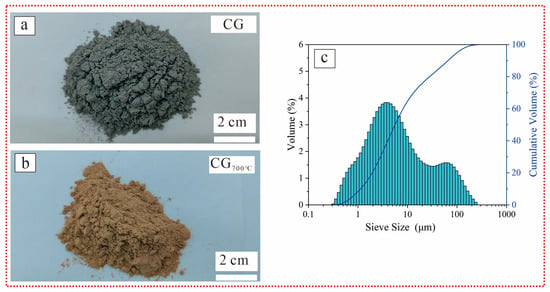
Figure 1.
Photos of CG of CG (a) and CG700°C (b); Particle distributions of CG700°C (c).
The XRD patterns of the samples denoted as CG and CG700°C were displayed in Figure 2a. The peak at approximately 26.3° (2θ) signified the existence of quartz, and the peak at approximately 12.3° (2θ) corresponded to kaolinite. Moreover, traces of muscovite and albite were contained in CG. After calcination, the reflections corresponding to kaolinite disappeared, and the spectrum of CG700°C featured a broad diffraction band centered at ~23.7° (2θ), indicating that the kaolinite had been transformed into an amorphous phase. However, the quartz existed in the CG700°C owing to its thermal stability. The SEM image of CG700°C is shown in Figure 2b,c. The SEM images at low magnification showed that CG700°C possessed irregular particles and a loose surface morphology (Figure 2b), and the SEM images at high magnification showed that the microstructure of CG700°C displayed a lamella shape (Figure 2c).
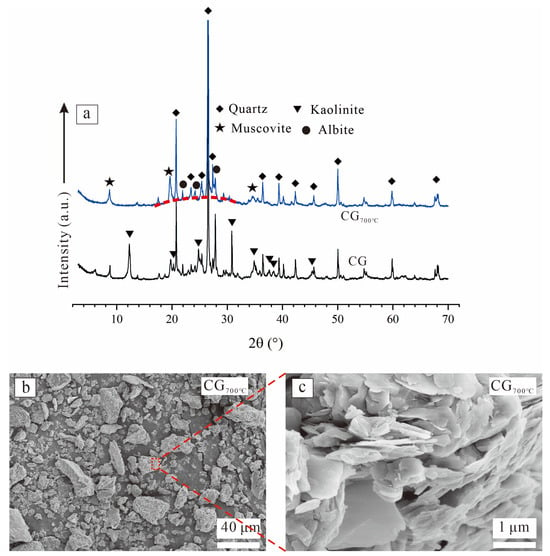
Figure 2.
(a) XRD patterns of CG and CG700°C; SEM images of CG700°C (b) and (c).
The alkali activators used in the study included a sodium silicate solution (Na2O 8.5 wt%, SiO2 27.3 wt%, H2O 64.2 wt%, and a modulus of 3.3) and sodium hydroxide (NaOH) particles with a purity exceeding 96%. The chemical reagents were procured from commercial suppliers, while the distilled water used was supplied by the laboratory.
2.2. Geopolymers Preparation
The preparation process was depicted in Figure 3, and the experimental conditions were listed in Table 2.

Figure 3.
Preparation of CG700°C-based geopolymers.

Table 2.
Mixture proportions of CG700°C-based geopolymers.
Preparation process. First, NaOH was added to distilled water to prepare a NaOH solution, which was then mixed with a Na2SiO3 solution to form an alkali activator. Second, CG700°C was blended with the alkali activators to produce a homogeneous gel slurry, which was forged into silica molds measuring 20 mm × 20 mm × 20 mm. Subsequently, a thin polyethylene film was applied to shield the slurry from water evaporation. The resulting specimens were then subjected to curing in a controlled environment at 60 °C for 24 h, followed by demolding and further curing at ambient temperature (~25 °C) for varying periods (3, 7, and 28 days) before testing.
The prepared geopolymers were marked as ‘GX-Y-Z’, where ‘X’ represents the Na2SiO3/NaOH mass ratio, ‘Y’ represents the NaOH concentration, and ‘Z’ represents the liquid–solid mass ratio. For example, ‘G2.0-10-0.55′ indicated the geopolymer specimens with a Na2SiO3/NaOH mass ratio of 2.0, a NaOH concentration of 10 mol/L, and a liquid–solid mass ratio of 0.55.
2.3. Characterisation Methods
The fluidity of the geopolymer slurry was tested using a truncated conical device from Hebei, China. The setting times of the geopolymer slurry were tested using a Vicat device from Shanghai, China. Compressive strength tests on the geopolymer specimens were conducted using a STS100K machine from Fujian, China, with a loading rate of 0.5 mm/min. Each group consisted of three specimens, and the compressive strength value was determined by averaging the results from the testing process.
The XRD patterns of the raw materials and the geopolymers were obtained using a Bruker D8 Advance diffractometer (Mannheim, Germany) within the range of 3–70° (2θ), the scanning rate was 3°/min. The FTIR spectra of the geopolymers were recorded using a Nicolet IS50 spectrometer (ThermoFisher, Waltham, MA, USA) across the range of 4000–400 cm−1, the resolution was 4 cm−1. The SEM images and EDX spectra of the geopolymers were captured using an S-3400N-II instrument (Hitachi, Tokyo, Japan) at a voltage of 35 kV and a current of 10 mA. The pore size distribution and the total pore volume were determined using an AutoPore IV 9510 porosimeter (Micromeritics, Norcross, GA, USA) with intrusion pressures ranging from 0.5 to 33,000 psi.
3. Results and Discussion
3.1. Setting Time and Compressive Strength
3.1.1. Fluidity and Setting Time
Figure 4 illustrates the initial and final setting times of geopolymers, while Table 2 indicates the fluidity of geopolymers. The fluidity of the specimens changed from 100.1 to 136.2 mm as the mixture proportions of alkali activators altered. However, the samples of GX-10-0.55 and G2.0-Y-0.55 seemed to be unaffected (around 112.5 mm) by the Na2SiO3/NaOH mass ratio or NaOH concentration change, but the paste fluidity increased more quickly when the liquid–solid mass ratio rose from 0.50 to 0.65, suggesting that the liquid–solid mass ratio significantly impacted paste fluidity. As the Na2SiO3/NaOH mass ratio increased, the setting times of the CG700°C-based geopolymer gels decreased. The final setting times of G1.2-10-0.55 and G2.4-10-0.55 were 127 and 87 min, respectively, representing a reduction of 23.7%. Similarly, studies have reported that the precursor binder activated by silicates showed faster hardening than hydroxides [39]. The high soluble silicate contents in the geopolymerization process favored the occurrence of geopolymer gels, which were beneficial for the formation of the pastes, and shortened the setting time of the hardened geopolymers.

Figure 4.
Setting times of geopolymers: (a) GX-10-0.55, (b) G2.0-Y-0.55, and (c) G2.0-10-Z.
In addition, as the NaOH concentration increased from 8 to 14 mol/L, it was observed that the final setting time of the CG700°C-based geopolymer gels gradually decreased, decreasing from 171 to 107 min, indicating that increasing alkalinity (i.e., the OH− concentration) promoted the diffusion of Si and Al from the CG700°C. The ions that were diffused through the hydrate reaction products then rapidly reacted with alkali solutions, which accelerated the reaction process of geopolymerization. These results were coherent with those observation by Bernal et al. [40]. The higher alkaline conditions were more strongly influenced by the dissolution of the slag, resulting in a reduction in setting times.
However, increasing the liquid–solid mass ratio prolonged both the initial and final setting times of the geopolymer gels. For example, the final setting time of G2.0-10-0.65 was 136 min, while G2.0-10-0.50 was 102 min. These results indicate that too much water inhibits the reaction rate of geopolymer gels. In other words, the presence of excess water will decrease the alkalinity of activators that adversely influence the dissolution of the CG700°C, thereby extending the setting times.
3.1.2. Compressive Strength
Figure 5 shows the compressive strengths and damages of different geopolymer samples. The strength of the geopolymers gradually increased over the curing duration, which indicated that geopolymerization was going, and the failure of geopolymer samples exhibited brittle damage (Figure 5d). Notably, the compressive strength of the geopolymers increased rapidly within 3 days of curing, reaching a level that was ~65% of the strength achieved after 28 days of curing. Furthermore, the strength between 3 and 7 days was slightly higher than that within the first 3 days. This trend was due to two factors: (1) more soluble silicates reacted during the early stages, and (2) the ambient temperature slowed down the geopolymerization process.
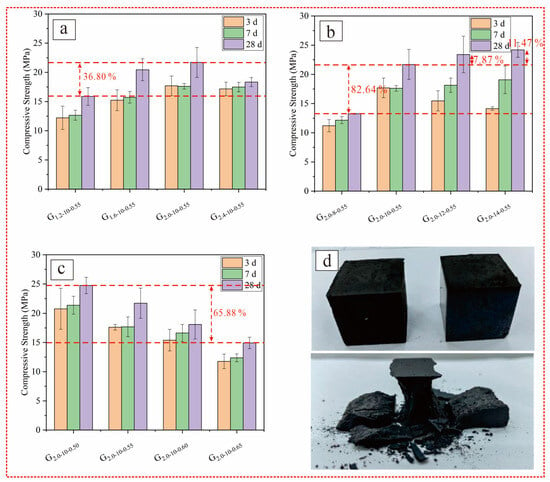
Figure 5.
Compressive strength of geopolymers (a) GX-10-0.55, (b) G2.0-Y-0.55, (c) G2.0-10-Z, and (d) damage photos of samples.
In addition, with an increasing Na2SiO3/NaOH mass ratio, the compressive strength of the geopolymers initially rose before subsequently declining. The 28 days compressive strength of G2.0-10-0.55 (21.71 MPa) was 36.80% higher than that of G1.2-10-0.55 (15.87 MPa). However, G2.4-10-0.55 exhibited a lower compressive strength (18.34 MPa) than G2.0-10-0.55 (21.71 MPa). This decrease can be attributed to the presence of surplus soluble silicate, leading to more geopolymer gels precipitating at an early stage, and those gels adhered to the raw materials would inhibit the condensation of SiO4 and AlO4 ions. These findings align with previous research findings [41,42]. Guo et al. [36] found the 28 days compressive strength of FA-based geopolymers exhibited an increase from 17.1 MPa to 59.3 MPa as the modulus (SiO2/Na2O) changed from 1.0 to 1.5.
Moreover, with an increase in NaOH concentration from 8 to 14 mol/L, there was an improvement in the compressive strength of the geopolymer. Specifically, the compressive strength of G2.0-14-0.55 increased by 94.11% compared to that of G2.0-8-0.55. Notably, the compressive strength saw an 82.64% increase as the NaOH concentration increased from 8 to 10 mol/L, followed by incremental increases of 7.87% and 3.60% as the NaOH concentration further increased from 10 to 12 mol/L and 12 to 14 mol/L, respectively. These results suggested that the low NaOH concentration inhibited the dissolution of CG700°C particles, thereby leading to the lower compressive strength of the geopolymers [43]. Moreover, the literature has shown the geopolymerization process was not only dependent on the dissolution rate of the precursor but also more relied on the condensation of SiO4 and AlO4 ions, which resulted in the formation of geopolymer networks. Therefore, the compressive strength experienced a rapid increase with the elevation of the NaOH concentration from 8 to 10 mol/L, followed by a slower rate of increase as the NaOH concentration continued to rise. Somna et al. [38] suggested the NaOH concentrations of ground fly ash-based geopolymers ranged from 9.5 mol/L to 14.0 mol/L.
With the rise in the liquid–solid ratio, the 28 days compressive strength gradually decreased. The compressive strength decreased from 24.75 MPa (G2.0-10-0.50) to 14.92 MPa (G2.0-10-0.65) as the liquid–solid ratio increased from 0.50 to 0.65. These results highlighted that the excess water in the geopolymerization process was unfavorable for the mechanical properties of CG700°C-based geopolymers. Zhang et al. [44] discovered that additional voids were introduced when the batched water evaporated in the geopolymer slurry, which was detrimental to enhancing compressive strength. Zhang et al. [37] pointed out that the lower liquid–solid ratio was beneficial for the polycondensation rate.
The relations between the compressive strength and the microstructure of the geopolymers will be discussed in the next sections.
3.2. Geopolymer Structure
3.2.1. XRD Analysis
Figure 6 displays the XRD patterns of the CG700°C-based geopolymers. The XRD spectra highlighted a wide reflection in the range of 18–34° (2θ), with a peak focused at ~28.3° (2θ). In comparison to the raw material of CG700°C (Figure 1a), the XRD patterns of the geopolymers shifted towards a higher angle (~28.3° vs. ~23.7° (2θ)), indicating that the connection between Si-O bonds and Al-O bonds increased, and more geopolymer gels were formed [45]. The geopolymer gels were probably N-A-S-H owing to the lower calcium content in the precursor [16,46], which contributed to the compressive strength of the samples. Additionally, minerals such as quartz, muscovite, and albite were detected in the geopolymers owing to their stable chemical reactivity, indicating that a certain amount of CG700°C did not participate in the geopolymerization reaction [47].

Figure 6.
XRD patterns of geopolymers: (a) GX-10-0.55, (b) G2.0-Y-0.55, and (c) G2.0-10-Z.
Furthermore, with an increase in the Na2SiO3/NaOH mass ratio, the samples featured no new diffraction peaks (Figure 6a), indicating that an increase in the soluble silicate content had minimal impact on the compound synthesis of the geopolymers. However, compared with the XRD patterns of G1.2-10-0.55, those of G2.0-10-0.55 and G2.4-10-0.55 featured lower intensities of quartz diffraction peaks, suggesting a greater consumption of quartz crystals in G2.0-10-0.55 and G2.4-10-0.55, as the increased Na2SiO3/NaOH mass ratio favored geopolymerization.
The elevation of the NaOH concentration seemed to reduce the intensity of quartz diffraction peaks in the geopolymers. Compared with G2.0-14-0.55, G2.0-8-0.55 exhibited a more pronounced intensity of quartz diffraction peaks, indicating that fewer CG700°C participated in geopolymerization at lower alkalinity conditions. Thus, a smaller amount of geopolymer gels was formed, resulting in lower compressive strength in G2.0-8-0.55. Additionally, with an increase in the curing duration (Figure 6b, 3 vs. 28 d), G2.0-8-0.55 (28 d) exhibited a more significant decrease in the intensity of the quartz diffraction peaks compared to G2.0-8-0.55 (3 d).
In addition, with an increase in the liquid–solid ratio, the XRD spectra featured no new diffraction peaks (Figure 6c), and the intensity of quartz diffraction peaks was not significantly influenced, suggesting that more water content did not influence the chemical composition of the geopolymers, and no new geopolymer gels formed with an increasing liquid–solid ratio. These findings align with those of Cui et al. [48]. Cui et al. [48] reported that adding more water could contribute to the dissolution of fly ash; however, this led to an increase in the porosity and pore sizes of fly ash-based geopolymers.
3.2.2. FTIR Spectroscopy
Figure 7 shows the FTIR spectra of CG700°C and geopolymer samples within the spectral range of 400–1800 cm−1. The spectra of the selected geopolymers exhibited a broad band centered at ~1020 cm−1, indicative of the asymmetrical stretching vibration linked to Si-O and Al-O bonds [49,50]. The bands observed at 801 and 780 cm−1 corresponded to the bending and stretching vibrations of Al-O bonds, consistent with findings from previous research [51]. Additionally, the bands at 480 cm−1 corresponded to the stretching vibration of Si-O-T bands, where T denotes either Si or Al, as supported by existing literature [52,53]. Moreover, the bands identified at 697 cm−1 corresponded to the internal extension of Si–O bonds, as referenced in a previous study [54]. Furthermore, the bands detected at 1646 cm−1 were related to the bending vibration of O-H bonds, in alignment with findings from various other studies [55,56,57].
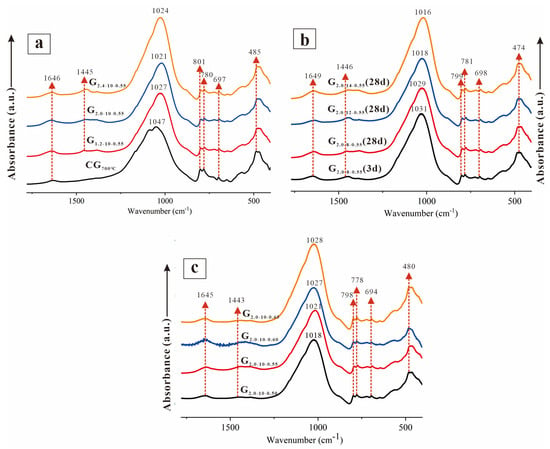
Figure 7.
FTIR spectra of geopolymers: (a) GX-10-0.55, (b) G2.0-Y-0.55, and (c) G2.0-10-Z.
In addition, the main band (wavenumbers: 900–1200 cm−1) of the CG700°C-based geopolymers shifted to lower wavenumbers after alkali activation, indicating that more amorphous products were produced [58,59,60]. The main bands shifted to lower wavenumbers in the spectra of G2.0-10-0.55 (1021 cm−1) and G2.4-10-0.55 (1024 cm−1), which compared to the specimen of G1.2-10-0.55 (1027 cm−1) (Figure 7a). As the curing time of G2.0-8-0.55 increased (Figure 7b), the wavenumbers of the main band in the spectra decreased from 1031 cm−1 (3 d) to 1029 cm−1 (28 d); Moreover, as the NaOH concentration increased from 8 to 14 mol/L or the liquid–solid ratio decreased from 0.65 to 0.50, the main bands shifted to lower wavenumbers. The literature [58,59,60,61] demonstrated that the adsorption band in the range around ~1030 cm−1 was associated with the asymmetric stretching vibration of Si-O-T bonds (where T = Si or Al), and the lower wavenumber specimens were induced by more Si atoms being replaced by Al atoms during geopolymerization. Moreover, the absorption band at 1445 cm−1 corresponded to the stretching vibration of C-O bonds [61], which was related to the carbonation of geopolymer gels. The raw material (CG700°C) did not show the absorption band due to no alkali activators applied.
3.2.3. SEM/EDX Results
Figure 8, Figure 9 and Figure 10 displays the SEM/EDX results of selected geopolymers. The microstructures of geopolymers with different Na2SiO3/NaOH mass ratios are shown in Figure 8a–g. The low-magnification SEM images (Figure 8a,c,e) showed that many pores existed in the CG700°C-based geopolymers. The high-magnification SEM images of the geopolymers revealed that the matrix featured some isolated particles and microcracks within the matrix of the geopolymers (Figure 8b,d,f), which contributed to the compressive strength.
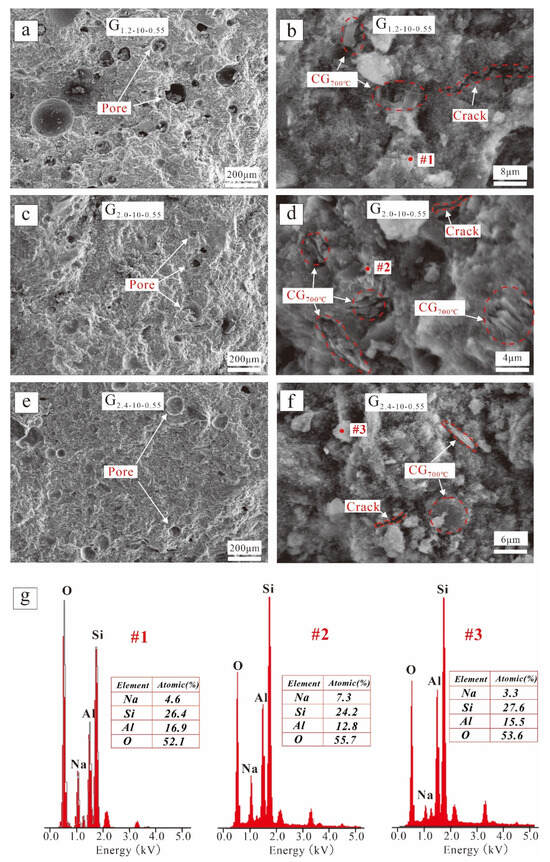
Figure 8.
SEM images of geopolymers: (a,b) G1.2-10-0.55, (c,d) G2.0-10-0.55, and (e,f) G2.4-10-0.55; (g) EDX results of spots highlighted in images (b,d,f).
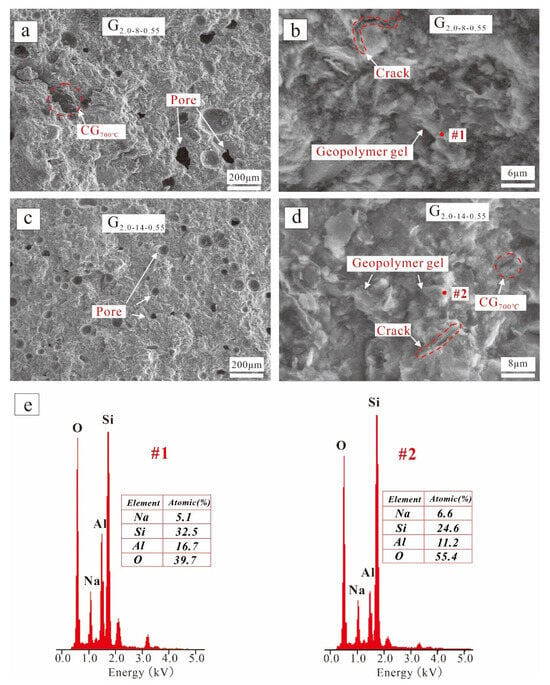
Figure 9.
SEM images of geopolymers: (a,b) G2.0-8-0.55, (c,d) G2.0-14-0.55, and (e) EDX results of spots highlighted in images (b,d).
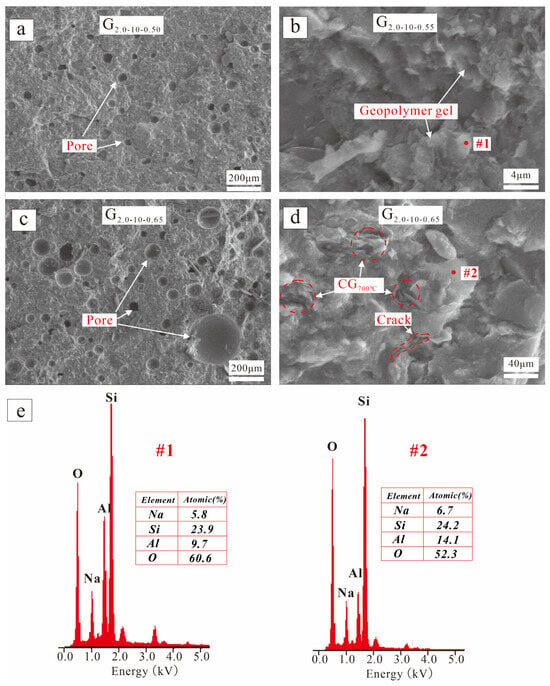
Figure 10.
SEM images of geopolymers: (a,b) G2.0-10-0.50, (c,d) G2.0-10-0.65, and (e) EDX results of spots highlighted in images (b,d).
Compared with G1.2-10-0.55, both G2.0-10-0.55 and G2.4-10-0.55 (Figure 8c,e) exhibited homogeneous and compact microstructures and smaller pore sizes. These findings demonstrated that increasing the Na2SiO3/NaOH mass ratios favored the geopolymerization of the CG700°C-based geopolymers, providing more soluble silicates to participate in geopolymerization reactions. The EDX results (Figure 8g, spots 1, 2, and 3) indicated that the geopolymer gels were primarily composed of Si, Al, Na, and O, forming N-A-S-H compounds. Moreover, the Si/Al ratios varied among the selected geopolymers. For instance, the Si/Al ratio of G1.2-10-0.55 was 1.56, considerably lower than those of G2.0-10-0.55 (1.89) and G2.4-10-0.55 (1.78). This discrepancy suggests that fewer Si atoms participated in geopolymerization at lower soluble silicate concentrations, consistent with the compressive strength findings in Figure 5.
However, as the concentration of NaOH increased from 8 to 14 mol/L, G2.0-8-0.55 exhibited a relatively loose structure (Figure 9a), and G2.0-14-0.55 exhibited a denser matrix (Figure 9c). In addition, isolated particles (Figure 9a,d) and microcracks (Figure 9b,d) were observed in the geopolymer matrix. The EDX results (Figure 9e, spot 1, 2) showed that G2.0-8-0.55 exhibited smaller Si/Al ratios than that of G2.0-14-0.55 (1.94 vs. 2.19), which resulted in lower compressive strength for G2.0-8-0.55.
Figure 10 illustrates the SEM images and EDX results of G2.0-10-0.50 and G2.0-10-0.65. The low-magnification SEM images (Figure 10a,c) showed that G2.0-10-0.50 and G2.0-10-0.65 exhibited no significant differences in morphology, except for the smaller pore sizes observed in G2.0-10-0.50. Additionally, more isolated particles occurred in G2.0-10-0.65 (Figure 10d). The smaller pore sizes of G2.0-10-0.50 were related to the higher compressive strength; the correlations would be discussed in the MIP.
3.2.4. MIP Results
Figure 11 displays the pore sizes and pore volume distribution of the selected geopolymers, while Table 3 provides the corresponding pore parameters obtained by MIP. According to Zhang et al. [62], pores were categorized into three categories: gel pores (1–10 nm), medium capillary pores (10–100 nm), and large capillary pores (100–1000 nm). The specimens G2.0-8-0.55 exhibited a larger critical pore size of 67.51 nm, and specimens G2.0-10-0.50 exhibited a smaller pore size of 25.01 nm. All of the samples had medium capillary pores (Figure 11a).
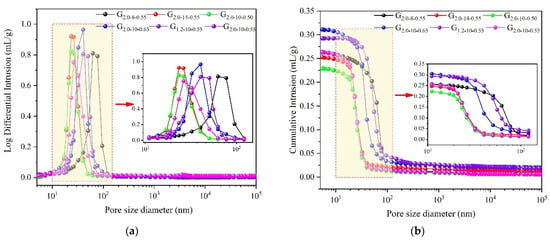
Figure 11.
MIP results of geopolymers: (a) log differential intrusion; (b) cumulative intrusion.

Table 3.
The pore parameters of geopolymers determined via MIP.
As the Na2SiO3/NaOH mass ratio elevated from 1.2 to 2.0, the average pore sizes of G1.2-10-0.55 and G2.0-10-0.55 were 41.03 and 27.24 nm, respectively, and the porosity of the corresponding samples decreased from 39.44% to 37.61%, indicating that more soluble silicates were beneficial for reducing both the pore size and pore volume. The cumulative intrusion of the geopolymers is depicted in Figure 10b. G2.0-10-0.55 exhibited a lower cumulative intrusion (0.251 mL/g) than that of G1.2-10-0.55 (0.287 mL/g), and those also demonstrated that the increase in the Na2SiO3/NaOH mass ratio resulted in the formation of a more compact microstructure.
Moreover, G2.0-14-0.55 exhibited a critical pore size of 26.31 mm and a porosity of 37.06%, which was lower than those of G2.0-8-0.55. These indicated that increasing the concentration of NaOH favored the pore microstructure. A previous study [63] reported that pore size significantly affected the mechanical properties of cement materials, particularly at larger pore sizes (>50 nm). Thus, the compressive strength of specimens with 14 mol/L (G2.0-14-0.55) was improved.
With the increase in the liquid–solid ratio from 0.50 to 0.65, the porosity of the geopolymers increased from 36.79% to 41.93%, and the average pore size increased from 24.84 to 35.66 mm (Table 3). In a study by Cui et al. [48], it was observed that with an increase in the H2O/Na2O ratio from 13 to 17, the pore size increased from 7.1 to 18.1 nm. Additionally, the smaller pore area confirmed that the pore diameter of G2.0-10-0.50 was smaller than that of G2.0-10-0.65, contributing to its increased compressive strength.
3.3. Summary and Discussion
This research revealed that alkali activators significantly influenced the compressive strength and microstructure of geopolymers, although the chemical composition of CG700°C-based geopolymers remained relatively unaffected. For example, an increase in the Na2SiO3/NaOH mass ratio from 1.2 to 2.4 resulted in a 36.80% enhancement in compressive strength after 28 days. Similarly, by increasing the NaOH concentration from 8 to 14 mol/L or reducing the liquid–solid ratio from 0.65 to 0.50, the 28 days compressive strength increased by 94.11% and 65.88%, respectively. Notably, the XRD patterns of the geopolymers did not feature new diffraction peaks (Figure 6), aligning with the results of previous research. Guo et al. [36] investigated the impact of modulus (SiO2/Na2O) on the compressive strength of FA-based geopolymers. The 28 days compressive strength increased from 17.1 MPa to 59.3 MPa as the modulus changed from 1.0 to 1.5. Zhang et al. [37] found the geopolymerization rate of calcined kaolin-based geopolymer accelerated and strengthened with an increase in the NaOH solution concentration from 3 mol/L to 12 mol/L. Somna et al. [38] suggested the NaOH concentrations of ground fly ash-based geopolymers ranged from 9.5 mol/L to 14.0 mol/L. Moreover, Zhang et al. [37] pointed out that the lower liquid–solid ratio promoted the polycondensation rate of the geopolymers.
Moreover, in the process of using CG700°C-based geopolymers, more attention should be paid to the alkali activators. In the present study, the NaOH concentration should be controlled at an appropriate dosage, and the Na2SiO3/NaOH mass ratio and the liquid–solid ratio should be controlled at 2.0 and 0.5, respectively, which can result in a dense microstructure and a higher compressive strength for the geopolymers. In the next research, some limitations are needed to be considered, such as the sample damage, the stress-strain curves, and the toughness improvement of CG700°C-based geopolymer concrete.
4. Conclusions
Alkali activators significantly influence the mechanical properties and microstructure of geopolymers. This research delved into the impact of varying factors such as the Na2SiO3/NaOH mass ratio, NaOH concentration, and liquid–solid ratio on the mechanical properties of geopolymers derived from coal gangue calcined at 700 °C (CG700°C). By conducting a series of spectroscopic and microscopic tests, the following conclusions were obtained.
As the Na2SiO3/NaOH mass ratio increased from 1.2 to 2.4, the 28 days compressive strength of G2.0-10-0.55 (21.71 MPa) was 36.80% higher than that of G1.2-10-0.55 (15.87 MPa). The surplus soluble silicate (G2.4-10-0.55) would lead to more geopolymer gels precipitating at an early stage, which inhibited the condensation of SiO4 and AlO4 ions. Moreover, a lower NaOH concentration inhibited the dissolution rate of CG700°C particles; the specimens (G2.0-8-0.55) exhibited a loose microstructure, which was inferior to the development of the compressive strength (13.25 MPa). Additionally, with an increase in the liquid–solid ratio from 0.50 to 0.65, the specimens with a liquid–solid ratio of 0.50 (G2.0-10-0.50) showed higher compressive strength (24.75 MPa), and the specimens of G2.0-10-0.65 exhibited larger pore sizes and lower compressive strength (14.92 MPa).
The CG700°C-based geopolymer gels were composed of N-A-S-H compounds, and the chemical composition was not considerably influenced by the alkali activators. With a lower Na2SiO3/NaOH mass ratio (G1.2-10-0.55), fewer Si atoms participated in geopolymerization, the microstructure of the geopolymers became loose, and more pores were produced, thus compressive strength decreased. The porosity of the geopolymers for the smaller NaOH concentrations (G2.0-8-0.55) and higher liquid–solid ratio (G2.0-10-0.65) were 38.22% and 41.93%, respectively.
These findings indicated that alkali activators significantly influenced the mechanical properties and microstructure of CG700°C-based geopolymers. The results can provide theoretical support for the reutilization of CG waste.
Author Contributions
Conceptualization, X.W., F.L. and B.Z.; data curation, X.W. and B.Z.; formal analysis, X.W., Z.P. and W.C.; funding acquisition, F.L., B.Z. and L.L.; investigation, Z.P. and W.C.; methodology, X.W. and B.Z.; resources, F.L. and L.L.; project administration, F.L. and B.Z.; software Z.P.; supervision, F.L.; writing—original draft preparation, X.W. and W.C.; writing—review and editing, X.W., F.M. and B.Z. All authors have read and agreed to the published version of the manuscript.
Funding
This research was funded by the National Natural Science Foundation of China, (Grant No. 12072080, 12032009, and 42302032); and the Basic and Applied Basic Research Foundation of Guangdong Province, (Grant No. 2023A1515012180).
Data Availability Statement
The original data will be available upon requirement. The data are not publicly available due to the project privacy.
Acknowledgments
The authors gratefully thanks all technical personnel from the Structural Laboratory of Guangdong University of Technology for their assistance during the experiment.
Conflicts of Interest
The authors declare that there have been no known competing financial interests or personal relationships that could have appeared to influence the work reported in this paper.
References
- Davidovits, J. Geopolymers: Inorganic Polymeric New Materials. J. Therm. Anal. Calorim. 1991, 37, 1633–1656. [Google Scholar] [CrossRef]
- Duxson, P.; Provis, J.L.; Lukey, G.C.; Deventer, J. The Role of Inorganic Polymer Technology in the Development of “Green Concrete”. Cem. Concr. Res. 2007, 37, 1590–1597. [Google Scholar] [CrossRef]
- Rickard, W.D.A.; Vickers, L.; van Riessen, A. Performance of Fibre Reinforced, Low Density Metakaolin Geopolymers under Simulated Fire Conditions. Appl. Clay Sci. 2013, 73, 71–77. [Google Scholar] [CrossRef]
- Zhang, J.; Shi, C.; Zhang, Z.; Ou, Z. Durability of Alkali-Activated Materials in Aggressive Environments: A Review on Recent Studies. Constr. Build. Mater. 2017, 152, 598–613. [Google Scholar] [CrossRef]
- McLellan, B.C.; Williams, R.P.; Lay, J.; van Riessen, A.; Corder, G.D. Costs and Carbon Emissions for Geopolymer Pastes in Comparison to Ordinary Portland Cement. J. Clean. Prod. 2011, 19, 1080–1090. [Google Scholar] [CrossRef]
- Shi, C.; Jiménez, A.F.; Palomo, A. New Cements for the 21st Century: The Pursuit of an Alternative to Portland Cement. Cem. Concr. Res. 2011, 41, 750–763. [Google Scholar] [CrossRef]
- Farooq, M.; Bhutta, A.; Banthia, N. Tensile Performance of Eco-Friendly Ductile Geopolymer Composites (EDGC) Incorporating Different Micro-Fibers. Cem. Concr. Compos. 2019, 103, 183–192. [Google Scholar] [CrossRef]
- Zhang, B.; Feng, Y.; Xie, J.; Dai, J.; Chen, W.; Xue, Z.; Li, L.; Li, Y.; Li, J. Effects of Pretreated Recycled Powder Substitution on Mechanical Properties and Microstructures of Alkali-Activated Cement. Constr. Build. Mater. 2023, 406, 133360. [Google Scholar] [CrossRef]
- Cloete, S.; Giuffrida, A.; Romano, M.C.; Zaabout, A. The Swing Adsorption Reactor Cluster for Post-Combustion CO2 Capture from Cement Plants. J. Clean. Prod. 2019, 223, 692–703. [Google Scholar] [CrossRef]
- Zhang, X.; Feng, X.; Wang, Z.; Jian, J.; Chen, S.; Luo, W.; Zhang, C. Experimental Study on the Physico-Mechanical Properties and Microstructure of Foam Concrete Mixed with Coal Gangue. Constr. Build. Mater. 2022, 359, 129428. [Google Scholar] [CrossRef]
- Zhang, B.; Yu, T.; Deng, L.; Li, Y.; Guo, H.; Zhou, J.; Li, L.; Peng, Y. Ion-Adsorption Type Rare Earth Tailings for Preparation of Alkali-Based Geopolymer with Capacity for Heavy Metals Immobilization. Cem. Concr. Compos. 2022, 134, 104768. [Google Scholar] [CrossRef]
- Pavithra, P.; Reddy, M.S.; Dinakar, P.; Rao, B.H.; Satpathy, B.K.; Mohanty, A.N. A Mix Design Procedure for Geopolymer Concrete with Fly Ash. J. Clean. Prod. 2016, 133, 117–125. [Google Scholar] [CrossRef]
- Wang, Q.; Guo, H.; Yu, T.; Yuan, P.; Deng, L.; Zhang, B. Utilization of Calcium Carbide Residue as Solid Alkali for Preparing Fly Ash-Based Geopolymers: Dependence of Compressive Strength and Microstructure on Calcium Carbide Residue, Water Content and Curing Temperature. Materials 2022, 15, 973. [Google Scholar] [CrossRef]
- El-Hassan, H.; Ismail, N. Effect of Process Parameters on the Performance of Fly Ash/GGBS Blended Geopolymer Composites. J. Sustain. Cem.-Based Mater. 2018, 7, 122–140. [Google Scholar] [CrossRef]
- Singh, S.; Aswath, M.U.; Ranganath, R.V. Effect of Mechanical Activation of Red Mud on the Strength of Geopolymer Binder. Constr. Build. Mater. 2018, 177, 91–101. [Google Scholar] [CrossRef]
- Zhang, B.; Guo, H.; Yuan, P.; Li, Y.; Wang, Q.; Deng, L.; Liu, D. Geopolymerization of Halloysite via Alkali-Activation: Dependence of Microstructures on Precalcination. Appl. Clay Sci. 2020, 185, 105375. [Google Scholar] [CrossRef]
- Zhang, B.; Yuan, P.; Guo, H.; Deng, L.; Li, Y.; Li, L.; Wang, Q.; Liu, D. Effect of Curing Conditions on the Microstructure and Mechanical Performance of Geopolymers Derived from Nanosized Tubular Halloysite. Constr. Build. Mater. 2021, 268, 121186. [Google Scholar] [CrossRef]
- Zhang, B.; Guo, H.; Deng, L.; Fan, W.; Yu, T.; Wang, Q. Undehydrated Kaolinite as Materials for the Preparation of Geopolymer through Phosphoric Acid-Activation. Appl. Clay Sci. 2020, 199, 105887. [Google Scholar] [CrossRef]
- Zhang, B.; Yu, T.; Guo, H.; Chen, J.; Liu, Y.; Yuan, P. Effect of the SiO2/Al2O3 Molar Ratio on the Microstructure and Properties of Clay-Based Geopolymers: A Comparative Study of Kaolinite-Based and Halloysite-Based Geopolymers. Clays Clay Miner. 2022, 70, 882–902. [Google Scholar] [CrossRef]
- Li, Z.; Gao, Y.; Zhang, J.; Zhang, C.; Chen, J.; Liu, C. Effect of Particle Size and Thermal Activation on the Coal Gangue Based Geopolymer. Mater. Chem. Phys. 2021, 267, 124657. [Google Scholar] [CrossRef]
- Han, J.Y.; Song, X.Y.; Gao, Z.H. Excitation Effect of Soluble Glass on Composite System with Calcined Coal Gangue and Slag. Appl. Mech. Mater. 2012, 174–177, 30–34. [Google Scholar] [CrossRef]
- Geng, J.; Zhou, M.; Li, Y.; Chen, Y.; Han, Y.; Wan, S.; Zhou, X.; Hou, H. Comparison of Red Mud and Coal Gangue Blended Geopolymers Synthesized through Thermal Activation and Mechanical Grinding Preactivation. Constr. Build. Mater. 2017, 153, 185–192. [Google Scholar] [CrossRef]
- Zhou, X. Study on the Reaction Degree of Calcined Coal Gangue Powder in Blended Cement by Selective Solution Method. Procedia Earth Planet. Sci. 2009, 1, 634–639. [Google Scholar] [CrossRef][Green Version]
- Ju, F.; Li, B.; Guo, S.; Xiao, M. Dynamic Characteristics of Gangues during Vertical Feeding in Solid Backfill Mining: A Case Study of the Wugou Coal Mine in China. Environ. Earth Sci. 2016, 75, 1389. [Google Scholar] [CrossRef]
- Liu, H.; Liu, Z. Recycling Utilization Patterns of Coal Mining Waste in China. Resour. Conserv. Recycl. 2010, 54, 1331–1340. [Google Scholar] [CrossRef]
- Liu, X. Low-Carbon Utilization of Coal Gangue under the Carbon Neutralization Strategy: A Short Review. J. Mater. Cycles Waste Manag. 2023, 25, 1978–1987. [Google Scholar] [CrossRef]
- Karimipour, A. Effect of Untreated Coal Waste as Fine and Coarse Aggregates Replacement on the Properties of Steel and Polypropylene Fibres Reinforced Concrete. Mech. Mater. 2020, 150, 103592. [Google Scholar] [CrossRef]
- Wu, J.; Bai, G.; Wang, P.; Liu, Y. Mechanical Properties of a New Type of Block Made from Shale and Coal Gangue. Constr. Build. Mater. 2018, 190, 796–804. [Google Scholar] [CrossRef]
- Zhao, H.; Wang, S.; Wang, R.; Shen, L.; Wang, Q. Utilization of Raw Coal Gangue as Coarse Aggregates in Pavement Concrete. Constr. Build. Mater. 2023, 378, 131062. [Google Scholar] [CrossRef]
- Guan, X.; Qiu, J.; Song, H.; Qin, Q.; Zhang, C. Stress–Strain Behaviour and Acoustic Emission Characteristic of Gangue Concrete under Axial Compression in Frost Environment. Constr. Build. Mater. 2019, 220, 476–488. [Google Scholar] [CrossRef]
- Zhang, W.; Dong, C.; Huang, P.; Sun, Q.; Li, M.; Chai, J. Experimental Study on the Characteristics of Activated Coal Gangue and Coal Gangue-Based Geopolymer. Energies 2020, 13, 2504. [Google Scholar] [CrossRef]
- Zhou, S.; Dong, J.; Yu, L.; Xu, C.; Jiao, X.; Wang, M. Effect of Activated Coal Gangue in North China on the Compressive Strength and Hydration Process of Cement. J. Mater. Civ. Eng. 2019, 31, 04019022. [Google Scholar] [CrossRef]
- Dassekpo, J.-B.M.; Feng, W.; Miao, L.; Dong, Z. Effect of Alkali Activators on Loess Geopolymer: Potential Waterproof Repair Material. J. Mater. Civ. Eng. 2021, 33, 04021247. [Google Scholar] [CrossRef]
- Chen, W.; Li, B.; Wang, J.; Thom, N. Effects of Alkali Dosage and Silicate Modulus on Autogenous Shrinkage of Alkali-Activated Slag Cement Paste. Cem. Concr. Res. 2021, 141, 106322. [Google Scholar] [CrossRef]
- Phoo-ngernkham, T.; Sata, V.; Hanjitsuwan, S.; Ridtirud, C.; Hatanaka, S.; Chindaprasirt, P. High Calcium Fly Ash Geopolymer Mortar Containing Portland Cement for Use as Repair Material. Constr. Build. Mater. 2015, 98, 482–488. [Google Scholar] [CrossRef]
- Guo, X.; Shi, H.; Dick, W.A. Compressive Strength and Microstructural Characteristics of Class C Fly Ash Geopolymer. Cem. Concr. Compos. 2010, 32, 142–147. [Google Scholar] [CrossRef]
- Zhang, Z.; Xiao, Y.; Huajun, Z.; Yue, C. Role of Water in the Synthesis of Calcined Kaolin-Based Geopolymer. Appl. Clay Sci. 2009, 43, 218–223. [Google Scholar] [CrossRef]
- Somna, K.; Jaturapitakkul, C.; Kajitvichyanukul, P.; Chindaprasirt, P. NaOH-Activated Ground Fly Ash Geopolymer Cured at Ambient Temperature. Fuel 2011, 90, 2118–2124. [Google Scholar] [CrossRef]
- Puligilla, S.; Chen, X.; Mondal, P. Understanding the Role of Silicate Concentration on the Early-Age Reaction Kinetics of a Calcium Containing Geopolymeric Binder. Constr. Build. Mater. 2018, 191, 206–215. [Google Scholar] [CrossRef]
- Bernal, S.A.; Provis, J.L.; Rose, V.; Mejía de Gutierrez, R. Evolution of Binder Structure in Sodium Silicate-Activated Slag-Metakaolin Blends. Cem. Concr. Compos. 2011, 33, 46–54. [Google Scholar] [CrossRef]
- Zhang, B.; Huang, D.; Li, L.; Lin, M.; Liu, Y.; Fang, W.; Lu, J.; Liu, F.; Li, Y.; Liu, Y.; et al. Effect of Magnesium Salt Contamination on the Microstructures and Properties of Metakaolinite-Based Geopolymer: The Role of MgCl2 and MgSO4. J. Mater. Res. Technol. 2022, 20, 4500–4514. [Google Scholar] [CrossRef]
- Zhang, M.; Islam, J. Use of Nano-Silica to Reduce Setting Time and Increase Early Strength of Concretes with High Volumes of Fly Ash or Slag. Constr. Build. Mater. 2012, 29, 573–580. [Google Scholar] [CrossRef]
- Longhi, M.A.; Walkley, B.; Rodríguez, E.D.; Kirchheim, A.P.; Zhang, Z.; Wang, H. New Selective Dissolution Process to Quantify Reaction Extent and Product Stability in Metakaolin-Based Geopolymers. Compos. Part B Eng. 2019, 176, 107172. [Google Scholar] [CrossRef]
- Zhang, Z.; Yao, X.; Zhu, H. Potential Application of Geopolymers as Protection Coatings for Marine Concrete: I. Basic Properties. Appl. Clay Sci. 2010, 49, 1–6. [Google Scholar] [CrossRef]
- White, C.E.; Provis, J.L.; Llobet, A.; Proffen, T.; van Deventer, J.S.J. Evolution of Local Structure in Geopolymer Gels: An In Situ Neutron Pair Distribution Function Analysis. J. Am. Ceram. Soc. 2011, 94, 3532–3539. [Google Scholar] [CrossRef]
- Chen, Z.; Li, J.-S.; Zhan, B.-J.; Sharma, U.; Poon, C.S. Compressive Strength and Microstructural Properties of Dry-Mixed Geopolymer Pastes Synthesized from GGBS and Sewage Sludge Ash. Constr. Build. Mater. 2018, 182, 597–607. [Google Scholar] [CrossRef]
- He, J.; Jie, Y.; Zhang, J.; Yu, Y.; Zhang, G. Synthesis and Characterization of Red Mud and Rice Husk Ash-Based Geopolymer Composites. Cem. Concr. Compos. 2013, 37, 108–118. [Google Scholar] [CrossRef]
- Cui, Y.; Wang, D.; Wang, Y.; Sun, R.; Rui, Y. Effects of the n(H2O: Na2Oeq) Ratio on the Geopolymerization Process and Microstructures of Fly Ash-Based Geopolymers. J. Non-Cryst. Solids 2019, 511, 19–28. [Google Scholar] [CrossRef]
- Lu, C.; Wang, Q.; Liu, Y.; Xue, T.; Yu, Q.; Chen, S. Influence of New Organic Alkali Activators on Microstructure and Strength of Fly Ash Geopolymer. Ceram. Int. 2022, 48, 12442–12449. [Google Scholar] [CrossRef]
- Dehghani, A.; Aslani, F.; Ghaebi Panah, N. Effects of Initial SiO2/Al2O3 Molar Ratio and Slag on Fly Ash-Based Ambient Cured Geopolymer Properties. Constr. Build. Mater. 2021, 293, 123527. [Google Scholar] [CrossRef]
- Yu, Q.; Li, S.; Li, H.; Chai, X.; Bi, X.; Liu, J.; Ohnuki, T. Synthesis and Characterization of Mn-Slag Based Geopolymer for Immobilization of Co. J. Clean. Prod. 2019, 234, 97–104. [Google Scholar] [CrossRef]
- Sun, Z.; Vollpracht, A. One Year Geopolymerisation of Sodium Silicate Activated Fly Ash and Metakaolin Geopolymers. Cem. Concr. Compos. 2019, 95, 98–110. [Google Scholar] [CrossRef]
- Koshy, N.; Dondrob, K.; Hu, L.; Wen, Q.; Meegoda, J.N. Synthesis and Characterization of Geopolymers Derived from Coal Gangue, Fly Ash and Red Mud. Constr. Build. Mater. 2019, 206, 287–296. [Google Scholar] [CrossRef]
- Ryu, G.S.; Lee, Y.B.; Koh, K.T.; Chung, Y.S. The Mechanical Properties of Fly Ash-Based Geopolymer Concrete with Alkaline Activators. Constr. Build. Mater. 2013, 47, 409–418. [Google Scholar] [CrossRef]
- Wang, Y.; Han, F.; Mu, J. Solidification/Stabilization Mechanism of Pb(II), Cd(II), Mn(II) and Cr(III) in Fly Ash Based Geopolymers. Constr. Build. Mater. 2018, 160, 818–827. [Google Scholar] [CrossRef]
- Fernández-Jiménez, A.; Palomo, A. Mid-Infrared Spectroscopic Studies of Alkali-Activated Fly Ash Structure. Microporous Mesoporous Mater. 2005, 86, 207–214. [Google Scholar] [CrossRef]
- Zhang, Z.; Provis, J.L.; Ma, X.; Reid, A.; Wang, H. Efflorescence and Subflorescence Induced Microstructural and Mechanical Evolution in Fly Ash-Based Geopolymers. Cem. Concr. Compos. 2018, 92, 165–177. [Google Scholar] [CrossRef]
- Rees, C.A.; Provis, J.L.; Lukey, G.C.; van Deventer, J.S.J. Attenuated Total Reflectance Fourier Transform Infrared Analysis of Fly Ash Geopolymer Gel Aging. Langmuir 2007, 23, 8170–8179. [Google Scholar] [CrossRef]
- Aiken, T.A.; Kwasny, J.; Sha, W.; Soutsos, M.N. Effect of Slag Content and Activator Dosage on the Resistance of Fly Ash Geopolymer Binders to Sulfuric Acid Attack. Cem. Concr. Res. 2018, 111, 23–40. [Google Scholar] [CrossRef]
- Yaseri, S.; Masoomi Verki, V.; Mahdikhani, M. Utilization of High Volume Cement Kiln Dust and Rice Husk Ash in the Production of Sustainable Geopolymer. J. Clean. Prod. 2019, 230, 592–602. [Google Scholar] [CrossRef]
- El Alouani, M.; Alehyen, S.; El Achouri, M.; Taibi, M. Preparation, Characterization, and Application of Metakaolin-Based Geopolymer for Removal of Methylene Blue from Aqueous Solution. J. Chem. 2019, 2019, e4212901. [Google Scholar] [CrossRef]
- Wang, Y.; Alrefaei, Y.; Dai, J. Silico-Aluminophosphate and Alkali-Aluminosilicate Geopolymers: A Comparative Review. Front. Mater. 2019, 6, 106. [Google Scholar] [CrossRef]
- Fan, Y.; Luan, H. Pore Structure in Concrete Exposed to Acid Deposit. Constr. Build. Mater. 2013, 49, 407–416. [Google Scholar] [CrossRef]
Disclaimer/Publisher’s Note: The statements, opinions and data contained in all publications are solely those of the individual author(s) and contributor(s) and not of MDPI and/or the editor(s). MDPI and/or the editor(s) disclaim responsibility for any injury to people or property resulting from any ideas, methods, instructions or products referred to in the content. |
© 2024 by the authors. Licensee MDPI, Basel, Switzerland. This article is an open access article distributed under the terms and conditions of the Creative Commons Attribution (CC BY) license (https://creativecommons.org/licenses/by/4.0/).